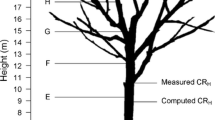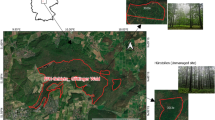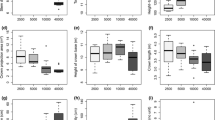Abstract
One of the first symptoms expressed by declining trees is reduced growth in stem diameter and length increment. The possibility of a relationship between length increment and crown thinning in beech (Fagus sylvatica L.) was investigated by developing a computer model to simulate first order branching patterns of the apical 2 m of monopodially branching beech trees, 70–100 years old, for a range of length increment rates. The model was based on values for branching angle, main axis and branch length increment, number of branches produced per year and branch mortality rates for six healthy and declining trees. Shoot growth rates in the apical 2 m of the sample trees ranged from about 5 cm/year (decline class 3) to 43 cm/ year (healthy). Simulations of branching patterns in the apical 2 m of trees growing at different rates indicated that, when growth rate exceeded about 20 cm/year, total first order branch length and area explored were independent of growth rate. When growth rates fell below this value there was a reduction in total area explored and first order branch length due primarily to the formation of fewer branches. More acute branching angles contributed to a reduction in the area explored. Growth rate-related crown thinning could increase the risk of bark necrosis and secondary pathogen infection during dry and/or hot spells.
Similar content being viewed by others
References
Barthélémy D, Caraglio Y, Drénou C, Figureau C (1993) Modélisation et simulation de l'architecture des arbres. Forêt-entreprise 83: 15–35
Bert GD (1993) Impact of ecological factors, climatic stresses, and pollution on growth and health of silver fir (Abies alba Mill.) in the Jura mountains: an ecological and dendrochronological study. Acta Oecologia 14: 229–246
Bräker OU (1991) Der Radialzuwachs an unterschiedlichen belaubten Buchen in zwei Beständen bei Zürich und Basel. Schweiz Z Forstwes 142 (5): 427–433
Ceulemans R, Hinckley TM, Heilman PE, Isebrands JG, Stettler RF (1989) Crown architecture in relation to productivity of Populus clones in the Pacific Northwest, USA. Ann Sci For 46 suppl: 199s-201s
Chapela IH, Boddy L (1988) Fungal colonization of attached beech branches. II. Spatial and temporal organization of communities arising from latent invaders in bark and functional sapwood, under different moisture regimes. New Phytol 110: 47–57
Colin PF, Houllier F, Joannes H, Haddaout A (1993) Modélisation du profil vertical des diamètres, angles et nombres de branches pour trois provenances d'Epicea commun. Silvae Genetica 42: 206–222
CPCS (1967) Classification des sols (française). Publ. INRA (Commission de pédologie et de classification des sols)
Darral NM (1989) The effect of air pollutants on physiological processes in plants. Plant Cell Environ 12: 1–30
Fischer H, Rommel WD (1989) Jahrringbreiten und Höhentrieblängen von Buchen mit unterschiedlicher Belaubungsdichte in Baden-Württemberg. AFZ 11: 264–265
Fisher JB (1992) How predictive are computer simulations of tree architecture? Int J Plant Sci 153: S137-S146
Flückiger W, Braun S (1988) Untersuchungen in Buchenbeobachtungsflächen. Waldschadensbericht (1984–1988). Institut für Angewandte Pflanzenbiologie, CH-4124 Schönenbuch, Switzerland
Flückiger W, Braun S (1994) Waldschaden-Bericht. Untersuchungen in Buchenbeobachtungsflächen (1984–1993). Institut für angewandte Pflanzenbiologie, CH-4124 Schönenbuch, Switzerland
Ford ED (1992) The control of tree structure and productivity through the interaction of morphological development and physiological processes. Int J Plant Sci 153: S147-S162
Ford ED, Avery A, Ford R (1990) Simulation of branch growth in the Pinaceae: interactions of morphology, phenology, foliage productivity, and the requirement for structural support, on the export of carbon. J Theor Biol 146: 15–36
Grauer M (1980) Les sols du Plateau vaudois. Mémoires de la Societé Vaudoise des Sciences Naturelles, no 99, vol 16 (3)
Gruber F (1988) Die Anpassung der Fichtenkrone (Picea abies (L.) Karst) über die Triebbildungsarten. Schweiz Z Forstwes 129: 173–201
Houston DR (1981) Stress triggered tree diseases. The diebacks and declines. USD A For Ser NE-INF-41–81, Northeastern Forest Experiment Station, Hamden Conn., USA
Houston DR (1992) A host-stress-saprogen model for forest diebackdecline diseases. In: Manion PD, Lachance D (eds) Forest decline concepts. APS Press, The American Phytopathological Society, St. Paul, Minnesota, pp. 3–26
Lévy G, Becker M (1987) Le dépérissement du sapin dans les Vosges: rôle primordial de déficits d'alimentation en eau. Ann Sci For 44: 403–416
Ling KA, Power SA, Ashmore MR (1993) A survey of the health of Fagus sylvatica in southern Britain. J App Ecol 30: 295–306
Manion PD (1991) Tree disease concepts (2nd edn). Prentice-Hall, Englewood Cliffs, N.J.
Manion PD, Lachance D (1992) Foreword. In: Manion PD, Lachance D (eds) Forest decline concepts. APS Press, The American Phytopathological Society, St. Paul, Minnesota
Matyssek R, Günthardt-Goerg MS, Saurer M, Keller T (1992) Seasonal growth δ13C in leaves and stem, and phloem structure of birch (Betula pendula) under low ozone concentrations. Trees 6: 69–76
Moor M (1976) Gedanken zur Systematik mitteleuropäischer Laubwälder. Schweiz Z Forstwes 52: 327–340
Parameswaran N, Fink S, Liese W (1985) Feinstrukturelle Untersuchungen an Nadeln geschädigter Tannen und Fichten aus Waldschadensgebieten im Schwarzwald. Eur J For Path 15: 168–182
Perrin R (1977) Le dépérissement du hêtre. RFF XXIX 2: 101–121
Power SA (1994) Temporal trends in twig growth of Fagus sylvatica L. and their relationships with environmental factors. Forestry 47: 13–30
Roloff A (1986) Morphologie der Kronenentwicklung von Fagus sylvatica L. (Rotbuche) unter besonderer Berücksichtigung möglicherweise neuartiger Veränderungen. Berichte des Forschungszentrums Waldökosysteme/Waldsterben, Bd 18, Institut für Forstbotanik der Universität Göttingen
Roloff A (1989) Entwicklung und Flexibilität der Baumkrone und ihre Bedeutung als Vitalitätsweiser. II Kronenentwicklung und Vitalitätsbeurteilung der Eichen, Reiterationen, Kurztrieblebensdauer und Beziehungen zwischen Krone und Wurzel. Schweiz Z Forstwes 140: 943–963
Ross EW (1964) Etiological and developmental studies of a dieback disease of Fraxinus americana L. Ph.D. thesis, State University College of Forestry at Syracuse University, N.Y.
SAS Institute (1988) SAS/STAT User's Guide. Release 6.03 edition. SAS Institute Inc. SAS Circle Box 8000, Cary, N.C.
Schutt JR, Shugart HH, Ranney JW (1986) Crown geometry of plantation-grown American sycamore and its simulation. Publication ORNL/TM-9721, Oak Ridge National Laboratory, Oak Ridge, Tenn
Spelsberg G (1989) Untersuchungen in einem kranken Buchenbestand im Forstamt Kottenforst. AFZ 49: 1320–1322
Stribley GH (1993) Studies on the health of beech trees in Surrey, England: relationship between winter canopy assessment by Roloff's method and twig analysis. Forestry 66: 1–26
Thiébaut B (1981) Observations sur le polymorphisme des axes du hêtre commun (Fagus sylvatica L.). orthotropie et plagiotropie. C R Acad Sci Ser 3, 293: 483–488
Thiébaut B, Puech S (1984) Technique et forêt. Développement du hêtre commun. Morphologie et architecture de l'arbre. 2e partie: le développement des arbres. RFF XXXV 1: 45–58
Thiébaut B, Cuguen J, Dupré S (1985) Architecture des jeunes hêtres Fagus sylvatica. Can J Bot 63: 2100–2110
Westman L, Lesinski J (1985) Thinning out of the tree crown —what is hidden in that integrated measure of forest damage? Inventory and Monitoring Endangered Forests. IUFRO Conference Zurich 1985, Birmensdorf, Eidg. Anstalt für das forstliche Versuchswesen, pp 223–228
Author information
Authors and Affiliations
Rights and permissions
About this article
Cite this article
Woodcock, H., Vollenweider, P., Dubs, R. et al. Crown alterations induced by decline: a study of relationships between growth rate and crown morphology in beech (Fagus sylvatica L.). Trees 9, 279–288 (1995). https://doi.org/10.1007/BF00202018
Received:
Accepted:
Issue Date:
DOI: https://doi.org/10.1007/BF00202018




